Have you ever wondered why one cat in your household has fleas while the other doesn’t? It may seem puzzling, but there are several factors that can contribute to this phenomenon. Understanding these factors can help you better manage and prevent flea infestations in your cat.
Differences in grooming habits, skin type, and overall health can play a role in why one cat may have fleas while the other remains flea-free. Some cats are more meticulous groomers, which can help them control and prevent flea infestations. Additionally, cats with sensitive skin or compromised immune systems may be more susceptible to flea bites.
Environmental factors also come into play. If one cat spends more time outdoors or has contact with other animals, they may have a higher likelihood of being exposed to fleas. Fleas can easily hitch a ride on animals or humans, making it possible for one cat to bring fleas into the home while the other remains unaffected.
When it comes to treating fleas in one cat, it’s important to address the issue promptly. Use veterinarian-recommended flea treatments to eliminate fleas from the infested cat and prevent reinfestation. It’s also crucial to take preventive measures to protect both cats from future flea infestations.
By regularly grooming both cats, vacuuming your home, and using flea preventatives, you can minimize the risk of fleas and keep your furry friends happy and healthy. Remember, prevention is key when it comes to fleas!
Key Takeaways:
- One cat can have fleas while the other remains flea-free due to differences in grooming habits, skin type, and overall health.
- Environmental factors, such as exposure to other animals and outdoor environments, can contribute to flea infestations in one cat only.
- Treating fleas in one cat requires prompt action using veterinarian-recommended flea treatments.
- Preventive measures, including regular grooming, vacuuming, and the use of flea preventatives, can help protect both cats from future flea infestations.
- Being proactive in flea prevention is essential to keep your cats happy and flea-free.
What are Fleas?
Fleas are parasitic insects that infest animals and can cause discomfort and health issues. They have unique anatomy that allows them to navigate through an animal’s fur and feed on blood. Female fleas can lay hundreds of eggs, which hatch into larvae and eventually transform into adult fleas. The life cycle of a flea consists of four stages: egg, larva, pupa, and adult. This life cycle can range from a matter of weeks to several months, depending on environmental conditions and the availability of hosts.
Fleas are not just a nuisance; they can also transmit diseases to animals and humans. Some common flea-borne diseases include tapeworm infestations and cat scratch fever. It is important to be aware of the signs of flea infestations and take appropriate measures to control and prevent them.

Flea Life Cycle
| Stage | Description |
|---|---|
| Egg | Female fleas lay eggs on the host animal or in the surrounding environment. |
| Larva | The eggs hatch into larvae, which feed on organic matter and flea dirt. |
| Pupa | The larvae spin cocoons and undergo transformation into adult fleas. |
| Adult | The adult fleas emerge from the cocoons and seek a host to feed on. |
Understanding the flea life cycle is essential for effective flea control. By targeting all stages of the life cycle, including eggs, larvae, pupae, and adult fleas, it is possible to break the cycle and eliminate infestations.
It is important to consult with a veterinarian for the proper treatment and prevention of fleas. They can recommend appropriate flea control products and provide guidance on maintaining a flea-free environment for the health and well-being of your pets.
Factors That Affect the Risk of Flea Infestations
When it comes to flea infestations in cats, several factors can influence the risk. These factors include age, environment, cat’s lifestyle, and cat’s health. Understanding these factors can help cat owners take appropriate preventive measures to keep their furry companions safe from fleas.
Age and Flea Infestations
Age plays a significant role in the risk of flea infestations. Kittens, with their underdeveloped immune systems and delicate skin, are more susceptible to flea bites and infestations. Older cats, particularly those with weakened immune systems, are also more prone to flea infestations. Therefore, it is essential to take extra care and provide appropriate flea preventive measures for kittens and senior cats.
Environment and Flea Infestations
The environment in which a cat lives can greatly impact the risk of flea infestations. Cats in multi-cat households or those that interact with other animals, such as outdoor cats, have a higher chance of coming into contact with fleas. Additionally, cats residing in areas with high flea populations, such as warm and humid climates, are at an increased risk. Maintaining a clean and flea-free environment and limiting exposure to other animals can help reduce the risk of infestations.
Cat’s Lifestyle and Flea Infestations
A cat’s lifestyle also influences the likelihood of flea infestations. Cats that spend time outdoors, where they can come into contact with infested animals or environments, are at a higher risk of flea infestations. Indoor cats, on the other hand, have a lower risk but are not immune to infestations. Even a brief interaction with an infested animal or exposure to fleas brought in by humans or second-hand items can lead to an infestation. It is crucial to assess the cat’s lifestyle and take appropriate preventive measures accordingly.
Cat’s Health and Flea Infestations
A cat’s overall health and well-being also impact the risk of flea infestations. A strong immune system can help a cat fight off fleas and reduce the severity of infestations. Good nutrition and regular veterinary care play a vital role in maintaining a cat’s health and immunity. Cats with underlying health conditions or nutritional deficiencies may be more susceptible to flea infestations. Therefore, ensuring the cat’s health through a balanced diet and regular vet check-ups can help lower the risk of fleas.
| Factors | Affects the Risk of Flea Infestations |
|---|---|
| Age | Young kittens and older cats are more susceptible. |
| Environment | Multi-cat households, high flea populations, and exposure to infested animals increase the risk. |
| Cat’s Lifestyle | Outdoor cats and those with interactions with infested animals or environments have a higher risk. |
| Cat’s Health | A strong immune system and good overall health can lower the risk. |
Different Levels of Sensitivity to Flea Bites
Cats can have varying levels of sensitivity to flea bites. While some cats may experience intense itching and discomfort from just a few flea bites, others may not show any signs of irritation. This difference in sensitivity can be attributed to individual variations in how cats react to flea saliva. Some cats may have a stronger allergic reaction to flea bites, resulting in more severe symptoms such as redness, swelling, and even hair loss.
One common condition associated with flea bites is flea allergy dermatitis (FAD). In cats with FAD, even a single flea bite can trigger an allergic reaction that leads to intense itching and skin inflammation. This can cause the cat to scratch, bite, and lick the affected areas, leading to further irritation and potential secondary infections.
It is important to note that not all cats with fleas exhibit signs of FAD or intense itching. Some cats may not be as sensitive to flea bites and may not show any visible signs of discomfort. However, even if a cat is not exhibiting symptoms, it is essential to address any flea infestations promptly to prevent the spread of fleas and potential health issues.
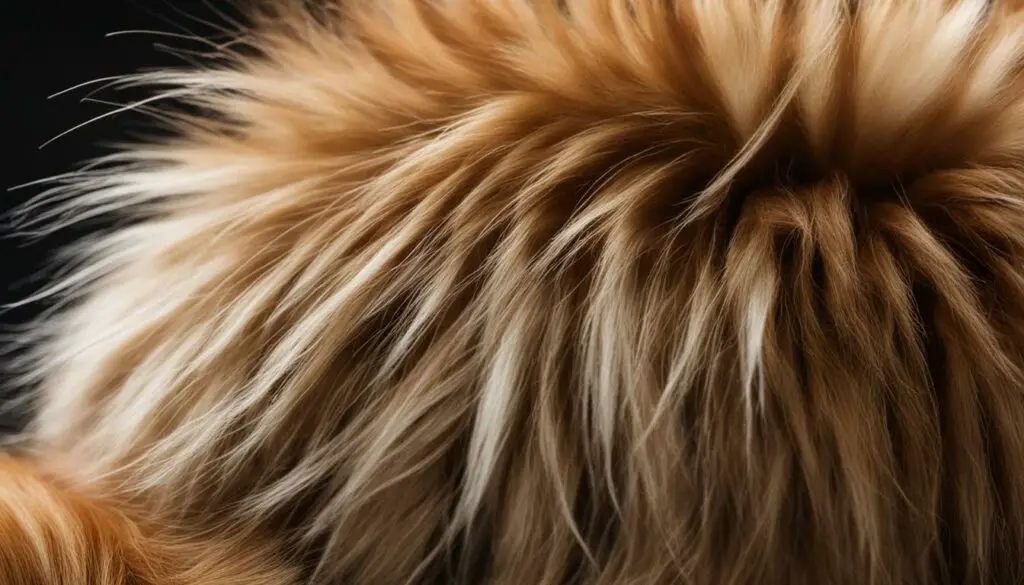
Flea Allergy Dermatitis (FAD)
Flea allergy dermatitis, or FAD, is a common condition caused by an allergic reaction to flea saliva. Cats with FAD are highly sensitive to flea bites and can experience severe itching and skin inflammation. Symptoms of FAD may include:
- Intense scratching and biting at the affected areas
- Redness, swelling, and small raised bumps on the skin
- Hair loss and skin lesions
- Secondary bacterial or fungal infections
If you suspect your cat has flea allergy dermatitis, it is important to consult with a veterinarian for proper diagnosis and treatment. Your vet can recommend effective flea control products, prescribe medications to relieve itching and inflammation, and provide guidance on managing the condition to minimize flare-ups.
How Can Fleas be Brought into the Home?
Bringing fleas into the home can happen in various ways and understanding the potential sources can help in preventing infestations. Fleas can easily find their way onto infested animals, such as stray cats or dogs, and hitchhike into your home. It’s crucial to be cautious when interacting with animals that may have fleas, as these pests can quickly jump onto humans and find their way indoors. Additionally, second-hand items like bedding or furniture can harbor fleas if not properly cleaned before bringing them into the home. Fleas, being agile and opportunistic, can also enter your home through open doors and windows, latching onto passing animals or humans.
To help visualize the different sources of flea infestations, let’s take a look at the following table:
| Source | Description |
|---|---|
| Infested Animals | Fleas can be brought into the home by animals that are already infested, such as stray cats or dogs. |
| Humans | If you come into contact with infested animals or environments, fleas can hitch a ride on your clothing or body and be transported into your home. |
| Second-Hand Items | Bedding, furniture, or other second-hand items can carry fleas if they were not properly cleaned before being brought into the home. |
| The Outdoors | Fleas can jump onto passing animals or humans while outdoors and find their way inside your home. |
By being aware of these potential sources, you can take steps to prevent fleas from entering your home. Regularly checking pets for fleas, practicing good hygiene, and treating infested animals promptly are crucial preventive measures. Additionally, thoroughly cleaning second-hand items before bringing them indoors can help prevent flea hitchhikers. Maintaining a clean and well-vacuumed environment can also minimize the risk of flea infestations.
Remember, preventing fleas from entering your home is much easier than dealing with a full-blown infestation. By taking proactive measures and being vigilant, you can help keep your home free from these pesky parasites and protect the health and happiness of your pets.

Can One Cat Have Fleas and Not the Other?
Yes, it is possible for one cat to have fleas while the other does not. Fleas can easily jump from one cat to another, so if one cat in a household has fleas, it is likely that the other cat has been exposed as well. However, not all cats react to flea bites in the same way, and some cats may be less attractive hosts for fleas. Regularly checking both cats for fleas and taking preventative measures, such as monthly flea treatments and maintaining a clean environment, can help prevent infestations in both cats.
In order to effectively treat fleas in one cat, it is important to follow a comprehensive approach. Start by using a flea comb to check the cat’s fur and remove any live fleas or flea dirt. You can also look for red bumps or scabs on the cat’s skin, as these can be signs of flea bites. If you find fleas or suspect a flea infestation, consult with your veterinarian for appropriate flea treatment options. There are various flea treatments available, including topical medications, oral medications, and flea collars.
“Regularly checking both cats for fleas and taking preventative measures, such as monthly flea treatments and maintaining a clean environment, can help prevent infestations in both cats.”
Preventing fleas in both cats is also crucial. Keep both cats on a regular flea prevention regimen to ensure they are protected against infestations. Additionally, maintain a clean environment by frequently vacuuming carpets, washing bedding, and treating any infested areas. This will help eliminate any fleas or eggs that may be present in the environment.
| Treating Fleas in One Cat | Preventing Fleas in Both Cats | |
|---|---|---|
| Step 1 | Use a flea comb to check for fleas and remove any live fleas or flea dirt. | Keep both cats on a regular flea prevention regimen. |
| Step 2 | Look for red bumps or scabs on the cat’s skin as a sign of flea bites. | Maintain a clean environment by vacuuming, washing bedding, and treating infested areas. |
| Step 3 | Consult with your veterinarian for appropriate flea treatment options. |
By following these steps and being proactive in flea prevention and treatment, you can ensure the health and comfort of both cats in your household.
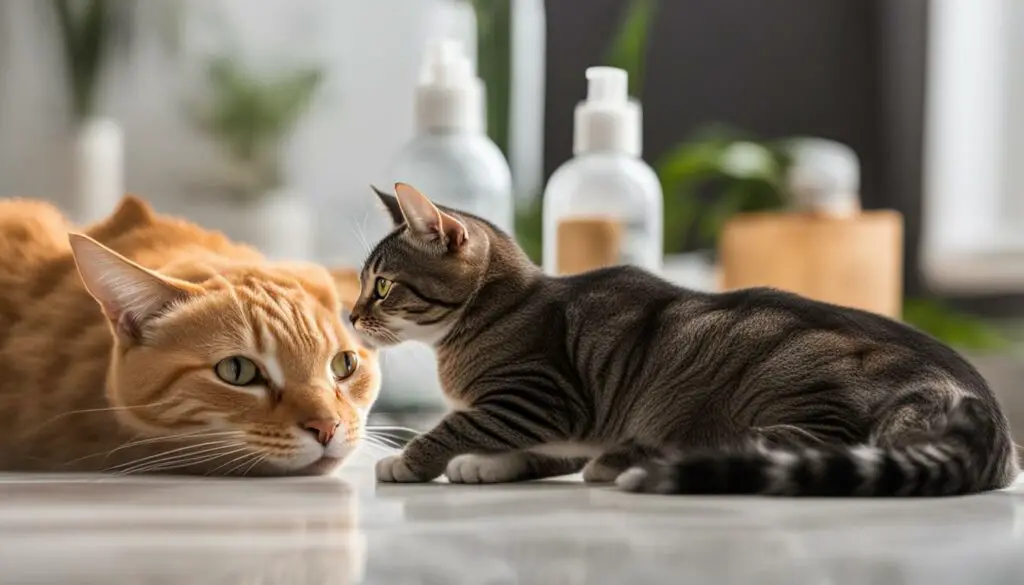
Signs of Fleas
When it comes to fleas, early detection is key to preventing a full-blown infestation. Keep an eye out for the following signs that may indicate your cat has fleas:
- Excessive scratching or biting: If your cat is constantly scratching or biting at their fur, it could be a sign of fleas. Fleas cause irritation and discomfort, leading to incessant itching.
- Flea dirt: Flea dirt is the feces of fleas and looks like tiny black specks. You may notice it on your cat’s fur or bedding. To check for flea dirt, comb your cat’s fur with a flea comb and inspect the comb for any black particles.
- Red bumps or scabs on the skin: Flea bites can cause inflammation and skin irritations, resulting in red bumps or scabs on your cat’s skin. These are often found around the neck, tail base, and hind legs.
If you notice any of these signs, it is important to take immediate action to address the flea infestation. Fleas can reproduce rapidly, and a small problem can quickly escalate into a larger one.

Use a Flea Comb
Grooming plays a crucial role in keeping cats healthy and flea-free. One effective tool for checking and removing fleas is a flea comb. The fine teeth of the comb can trap and remove fleas from the fur, providing a closer inspection.
To use a flea comb, start at the head and carefully comb through the fur, paying close attention to areas where fleas are commonly found, such as the neck, base of the tail, and back of the hind legs. After each stroke, inspect the comb to see if any fleas or flea dirt have been collected. Removing fleas with a comb not only helps eliminate them but also reduces the risk of flea eggs and larvae being spread around the environment.
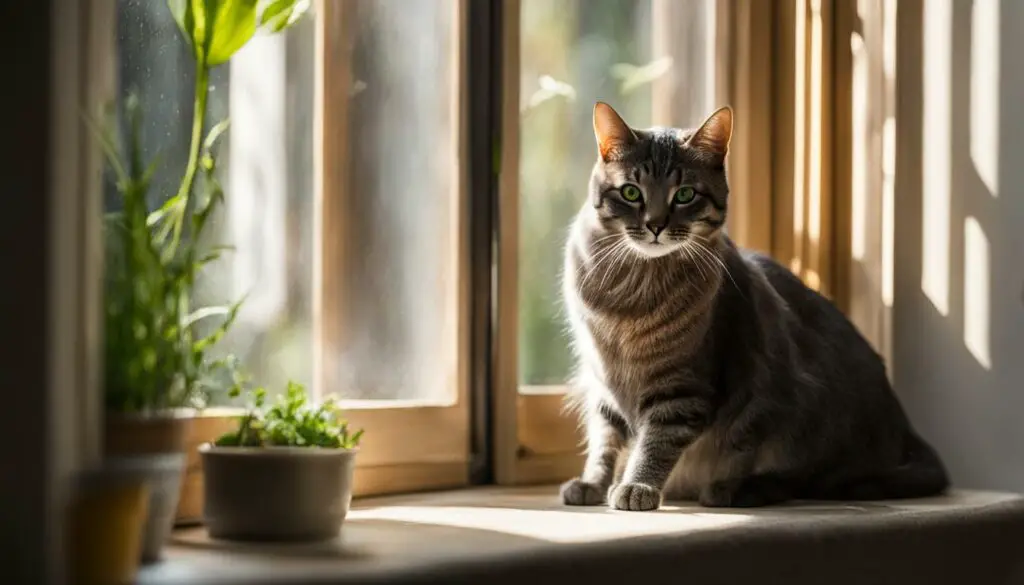
Checking for Fleas with a Comb
Regularly checking your cat for fleas with a flea comb can help detect infestations early and prevent them from spreading. While combing, keep an eye out for small black specks on the comb or your cat’s fur. These specks, known as flea dirt, are actually flea feces and can indicate the presence of fleas.
Using a flea comb is an essential part of my grooming routine for my cats. It allows me to closely examine their fur and keep them flea-free. Plus, my cats seem to enjoy the extra attention during our grooming sessions!
- Benefits of using a flea comb:
- Allows for closer inspection of the cat’s fur
- Traps and removes fleas
- Helps detect flea infestations early
- Reduces the risk of spreading flea eggs and larvae
Look for Red Bumps or Scabs
If you notice red bumps or scabs on your cat’s skin, it could be a sign of flea bites. Fleas are small parasites that feed on the blood of animals, including cats. When fleas bite, they inject saliva into the skin, which can cause an allergic reaction in some cats. This allergic reaction leads to the formation of red bumps or scabs.
It’s important to closely examine your cat’s skin for any signs of irritation or infection. If you see red bumps or scabs, it’s best to consult a veterinarian for a proper diagnosis and treatment plan. The veterinarian may recommend flea control products and treatments to eliminate the fleas and provide relief for your cat’s skin.
While treating the flea infestation is crucial, it’s also important to address any underlying skin irritations. Some cats may develop secondary skin infections from excessive scratching or biting at flea bites. The veterinarian may prescribe antibiotics or other medications to treat any infections and promote healing.
| Signs of Flea Bites |
|---|
| – Red bumps or scabs on the skin |
| – Excessive scratching or biting |
| – Presence of flea dirt (tiny black specks) |
| – Hair loss or thinning |
| – Restlessness or agitation |
Remember, prevention is key when it comes to flea infestations. Regularly grooming your cat, vacuuming the house, and using flea preventatives recommended by a veterinarian can help keep your cat flea-free and minimize the risk of skin irritations caused by flea bites.
Treat All Your Cats
When dealing with a flea infestation in a multi-cat household, it is important to treat all of your cats, even if only one of them is showing signs of fleas. Treating all cats helps prevent the spread of fleas and ensures that each cat receives the necessary treatment to eliminate the infestation.
Fleas can easily jump from one cat to another, so if you only treat the cat with visible fleas, the untreated cats are at risk of becoming infested as well. Fleas are highly resilient parasites that can quickly reproduce and spread throughout your home, making it challenging to eradicate them completely.
By treating all of your cats, you break the flea life cycle and prevent reinfestation. Additionally, some cats may be more attractive hosts for fleas than others due to differences in grooming habits, skin type, or overall health. Treating all cats ensures that no cat becomes a continuous source of fleas for the others.
Preventing Flea Transmission Between Cats
In addition to treating all cats for fleas, there are other measures you can take to prevent flea transmission between them. Regularly grooming your cats with a flea comb can help remove any fleas or flea dirt that may be present. It is also important to maintain a clean environment by vacuuming regularly and washing bedding and furniture.
Using flea preventatives, such as topical treatments or oral medications, can provide long-lasting protection against fleas and help prevent transmission between cats. Consult with your veterinarian to determine the most suitable flea preventative for your cats based on their individual needs and circumstances.
| Treating All Cats for Fleas in a Multi-Cat Household | Preventing Flea Transmission Between Cats |
|---|---|
| 1. Treat all cats, even if only one has visible fleas. | 1. Regularly groom your cats with a flea comb. |
| 2. Prevent the spread of fleas and ensure complete eradication. | 2. Maintain a clean environment by vacuuming and washing bedding. |
| 3. Break the flea life cycle and eliminate reinfestation. | 3. Use flea preventatives recommended by your veterinarian. |
Take Preventive Measures
Preventing flea infestations in cats is essential for their health and well-being. By taking proactive measures, you can significantly reduce the risk of your cats being plagued by fleas. Here are some key preventative measures to consider:
1. Monthly flea treatments
Regularly applying monthly flea treatments to all cats in your household is an effective way to prevent fleas from establishing a presence. These treatments can come in the form of spot-on treatments, oral medications, or flea collars. Consult with your veterinarian to determine the best option for your cats’ specific needs.
2. Maintaining a clean environment
Keeping your home clean is crucial in preventing flea infestations. Vacuuming carpets, rugs, and furniture on a regular basis helps remove flea eggs, larvae, and adult fleas. Pay extra attention to areas where your cats spend most of their time, such as their bedding and favorite lounging spots. Additionally, washing your cats’ bedding and using flea sprays or treatments on furniture can help eliminate fleas and their eggs.
3. Flea preventatives for cats
Using flea preventatives specifically formulated for cats is another important preventive measure. These products are designed to repel and kill fleas, preventing infestations. They come in various forms, including topical spot-on treatments, oral medications, and flea collars. Remember to follow the instructions provided by the manufacturer and consult your veterinarian for the most suitable option for your cats.
Taking these preventive measures will go a long way in keeping your cats flea-free and ensuring their overall well-being. Remember to regularly groom your cats, vacuum your home, and use appropriate flea preventatives to keep fleas at bay. By being proactive and attentive to flea prevention, you can provide a comfortable and safe environment for your beloved feline companions.
Tips to Prevent Flea Infestations
To keep your cats happy and healthy, it’s important to take preventive measures to avoid flea infestations. By following these simple tips, you can significantly reduce the risk of your cats getting fleas:
- Regular grooming: Grooming your cats regularly is an effective way to prevent fleas. Use a flea comb to remove any fleas or flea dirt from their fur. This not only helps to detect fleas early but also keeps their coats clean and healthy.
- Vacuum regularly: Fleas can hide in carpets, rugs, and upholstery, so it’s essential to vacuum your home regularly. Pay special attention to areas where your cats spend time, such as bedding, furniture, and their favorite spots. Vacuuming helps to remove flea eggs and larvae, breaking the flea life cycle.
- Use flea preventatives: There are various flea preventatives available, including topical treatments, oral medications, and flea collars. Consult your veterinarian to determine the most suitable option for your cats. Regularly applying flea preventatives can provide long-lasting protection against fleas.
- Maintain home cleanliness: Keeping your home clean is crucial in preventing flea infestations. Wash your cats’ bedding regularly in hot water to kill any fleas or eggs. Clean and vacuum areas where your cats spend time, such as floors, furniture, and pet crates. A clean environment reduces the likelihood of fleas taking hold.
- Treat all pets in the household: If you have multiple pets, it’s essential to treat all of them for fleas, even if only one is showing signs of infestation. Fleas can easily spread from one pet to another, so treating all pets simultaneously ensures that fleas are eliminated effectively.
By incorporating these preventive measures into your routine, you can greatly reduce the risk of flea infestations and keep your cats comfortable and happy. Remember to consult with your veterinarian for personalized advice on flea prevention and treatment options for your pets.
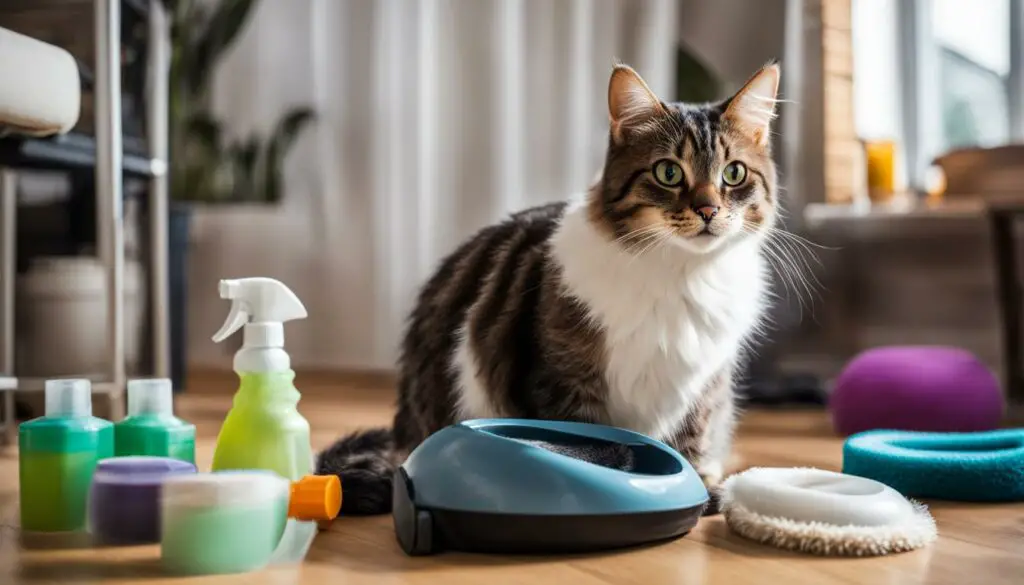
Regular Grooming
Regular grooming plays a crucial role in preventing flea infestations in cats. By dedicating time to grooming your cat, you can remove any existing fleas or flea dirt from their fur, as well as create an environment that is less attractive to fleas. Grooming sessions also provide an opportunity to closely inspect your cat’s skin for any signs of fleas or irritation.
One effective grooming tool for controlling fleas is a flea comb. Using a fine-toothed flea comb, comb through your cat’s fur, paying close attention to areas where fleas are commonly found, such as the neck, base of the tail, and back of the hind legs. The comb’s teeth can trap and remove fleas, allowing for closer inspection. Make sure to check the comb after each stroke to see if any fleas or flea dirt have been collected.
In addition to using a flea comb, brushing your cat’s fur regularly can help prevent matting and create a healthy environment that is less hospitable to fleas. Brushing not only removes loose hair and stimulates blood circulation, but it also helps distribute natural oils throughout the fur, making it harder for fleas to navigate and settle. Regular grooming also allows you to bond with your cat and keep their coat in top condition.

Benefits of Regular Grooming:
- Removes fleas and flea dirt from the fur
- Helps prevent matting and tangles
- Stimulates blood circulation and distributes natural oils
- Creates a healthier and less attractive environment for fleas
- Allows for closer inspection of the cat’s skin for signs of fleas or irritation
Vacuum regularly
Vacuuming regularly is an essential part of flea prevention in your home. By removing flea eggs and larvae with a vacuum, you can effectively interrupt the flea life cycle and reduce the risk of infestation. Not only does vacuuming help eliminate existing fleas, but it also provides a proactive approach to controlling the population and preventing future problems.
When vacuuming for flea prevention, it is crucial to pay attention to areas where fleas are likely to hide. These include carpets, rugs, upholstered furniture, and pet bedding. Be thorough in your vacuuming, making sure to reach corners, crevices, and areas under furniture where fleas may lurk. Remember to vacuum all areas where your pets spend time, as these are prime spots for fleas to congregate.
Keeping your home clean is another vital aspect of flea prevention. In addition to regular vacuuming, washing pet bedding and upholstery can help eliminate flea eggs and larvae that may be hiding in these areas. Maintaining a clean environment ensures that fleas have fewer places to hide and makes it more difficult for them to establish a presence in your home.
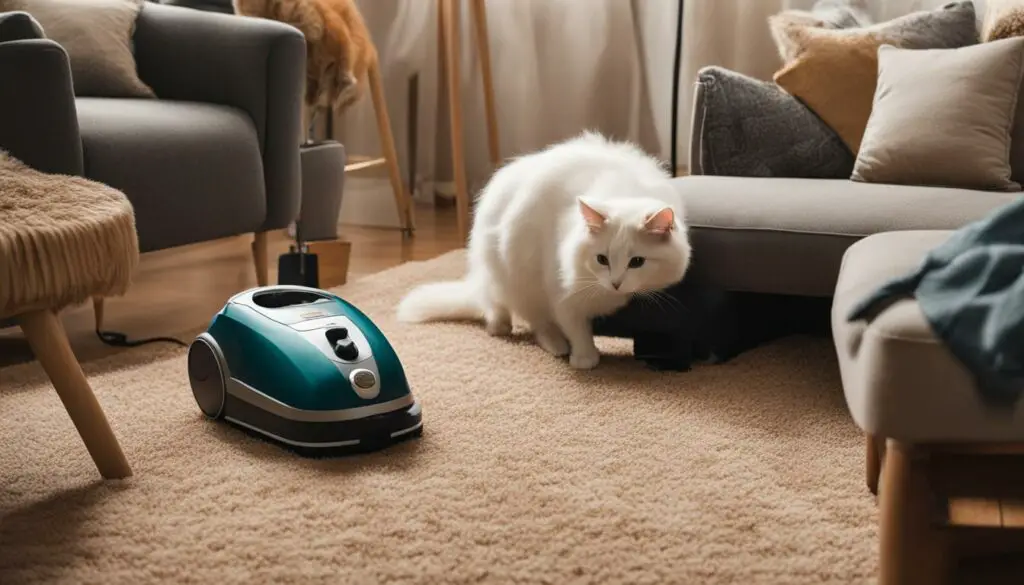
| Benefits of Regular Vacuuming for Flea Prevention | Tips for Effective Vacuuming |
|---|---|
|
|
“Regular vacuuming is a simple yet effective way to prevent fleas in your home. By removing flea eggs and larvae, you can disrupt the flea life cycle and significantly reduce the risk of infestation.”
Use flea preventatives
When it comes to protecting your cats from fleas, using flea preventatives is key. There are a variety of options available, including topical flea treatments, oral flea medications, and flea collars. These preventatives are designed to kill and repel fleas, preventing infestations and keeping your furry friends safe.
Topical flea treatments, such as spot-on treatments, are applied directly to your cat’s skin. They provide long-lasting protection against fleas and often kill other parasites, such as ticks and mosquitoes. These treatments are easy to apply and are typically effective for several weeks.
Oral flea medications are another popular choice. These medications are given to your cat orally and work by circulating through their bloodstream. When a flea bites your cat, it ingests the medication and is killed. Oral flea medications are convenient and can provide protection for up to a month.
Flea collars are a convenient option for preventing flea infestations. These collars contain chemicals that repel and kill fleas. They are easy to use and provide continuous protection against fleas for several months. It’s important to choose a flea collar that is specifically designed for cats, as some collars meant for dogs may contain ingredients that are toxic to cats.
| Flea Preventative | Advantages | Disadvantages |
|---|---|---|
| Topical Treatments | – Easy to apply – Long-lasting protection – Effective against other parasites |
– May cause skin irritation in some cats – Can be toxic if ingested by other animals |
| Oral Medications | – Convenient – Provides systemic protection – Safe for cats |
– May require monthly dosing – Some cats may have difficulty taking oral medications |
| Flea Collars | – Easy to use – Long-lasting protection – Repels and kills fleas |
– Some collars may contain toxic ingredients for cats – May cause allergic reactions in some cats |
When choosing a flea preventative for your cats, it’s important to consult with your veterinarian. They can recommend the best option based on your cat’s age, health, and lifestyle. Remember to follow the instructions and dosage guidelines provided by the manufacturer for the safety and effectiveness of the product. By using flea preventatives, you can protect your cats from the discomfort and health risks associated with fleas.
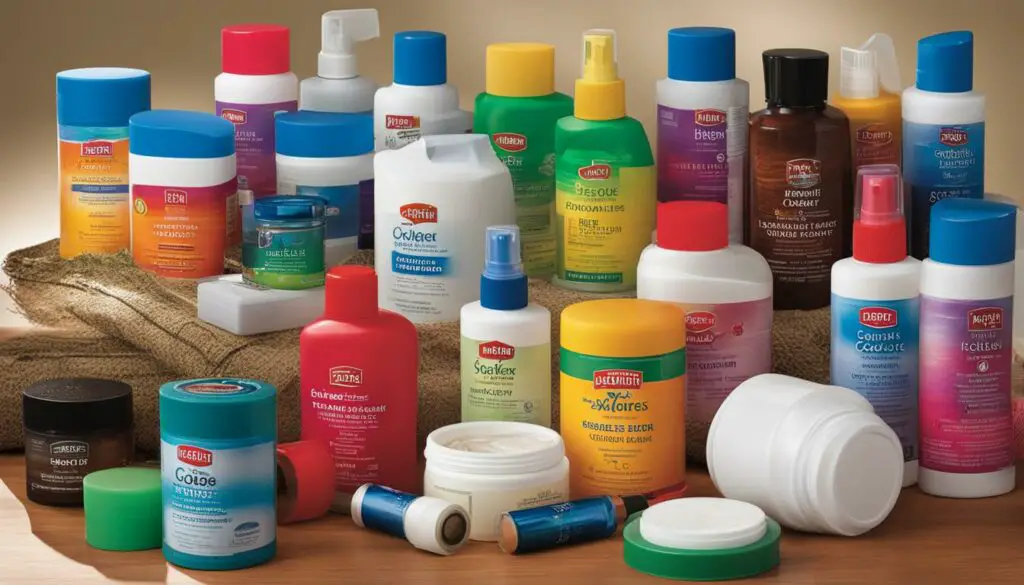
Conclusion
In conclusion, preventing fleas in cats requires a proactive and comprehensive approach. While it is possible for one cat to have fleas while the other doesn’t, understanding the factors that contribute to this situation is crucial. Differences in grooming habits, skin type, and overall health can make one cat more susceptible to fleas. Additionally, environmental factors such as exposure to other animals and the presence of fleas in the surroundings can increase the risk of infestation.
To keep all cats in the household safe from fleas, it is important to take preventive measures. Regular grooming, which includes using a flea comb and brushing the cat’s fur, can help remove fleas and detect any signs of infestation. Vacuuming the home regularly, paying extra attention to areas where pets spend time, can eliminate flea eggs and larvae. Using veterinarian-recommended flea preventatives, such as topical treatments, oral medications, or flea collars, can provide long-lasting protection against fleas.
By combining these preventive measures, pet owners can create a flea-free environment for their cats. Regular monitoring, prompt treatment, and maintaining a clean and hygienic living space are key to preventing flea infestations. Remember, early detection and intervention are essential in controlling and eliminating fleas. By staying vigilant and proactive, you can ensure the health and well-being of your feline companions.
FAQ
Can one cat have fleas and not the other?
Yes, it is possible for one cat to have fleas while the other doesn’t. There are several factors that can contribute to this, including differences in grooming habits, skin type, and overall health.
What are fleas?
Fleas are parasites that can cause discomfort and health issues in animals. They have unique anatomy that allows them to navigate through an animal’s fur and feed on blood. Female fleas can lay hundreds of eggs, which hatch into larvae and eventually transform into adult fleas.
What factors affect the risk of flea infestations?
Age, environment, lifestyle, and overall health can all affect the risk of flea infestations in cats. Kittens and older cats may be more vulnerable, living in multi-cat households or areas with high flea populations can increase the risk, and a cat’s immune system and nutrition can also impact susceptibility.
Can cats have different levels of sensitivity to flea bites?
Yes, cats can have varying levels of sensitivity to flea bites. Some may have intense itching and discomfort, while others may not show any signs of irritation. This can be due to individual differences in how cats react to flea saliva.
How can fleas be brought into the home?
Fleas can be brought into the home through infested animals, including other pets or animals in the environment. They can also hitchhike on humans, especially if they have been in contact with infested animals or environments. Second-hand items and fleas from the outdoors can also introduce fleas into the home.
Can one cat have fleas and not the other?
Yes, it is possible for one cat to have fleas while the other doesn’t. Fleas can easily jump from one cat to another, but not all cats react to flea bites in the same way. Regularly checking both cats for fleas and taking preventative measures can help prevent infestations in both cats.
What are the signs of fleas on a cat?
Signs of fleas on a cat can include excessive scratching or biting, hair loss, restlessness or agitation, the presence of fleas or flea dirt on the fur, and red bumps or scabs on the skin. Excessive grooming may also be a sign of fleas.
How can I use a flea comb to check for fleas?
Using a flea comb is an effective way to check for fleas on a cat. Start at the head and comb through the fur, paying close attention to areas where fleas are commonly found. Inspect the comb after each stroke to see if any fleas or flea dirt have been collected.
What do red bumps or scabs on a cat’s skin indicate?
Red bumps or scabs on a cat’s skin can be a sign of flea bites. They can occur due to the cat’s allergic reaction to flea saliva or from excessive scratching or biting at flea bites.
Should I treat all cats in the household for fleas?
Yes, it is essential to treat all cats in a household for fleas, even if only one cat is showing signs of infestation. Fleas can easily spread between cats, and treating only one cat may not effectively control the infestation.
What preventive measures can I take to control fleas?
Taking preventive measures such as regular grooming, vacuuming, using flea preventatives, and maintaining a clean environment can help control and prevent flea infestations in cats.
How can I prevent flea infestations in cats?
Tips to prevent flea infestations include regular grooming, vacuuming carpets and furniture, using flea preventatives recommended by a veterinarian, and keeping the home clean by washing bedding and treating all pets in the household.
Why is regular grooming important for preventing fleas?
Regular grooming, including combing or brushing a cat’s fur, can help remove fleas and flea dirt from their fur. It also allows for closer inspection of the cat’s skin for any signs of fleas or irritation.
How can vacuuming regularly help prevent fleas?
Vacuuming regularly removes fleas, flea dirt, eggs, and larvae from carpets, rugs, and furniture, helping to break the flea life cycle. It is important to vacuum all areas where pets spend time, paying attention to corners, crevices, and under furniture.
What are the different types of flea preventatives?
There are various flea preventatives available, including topical treatments, oral medications, and flea collars. Topical treatments are applied directly to the cat’s skin, oral medications are given to treat and prevent fleas, and flea collars repel fleas and prevent infestations.
Source Links
- https://www.21cats.org/is-it-possible-for-one-cat-to-have-fleas-and-not-the-other/
- https://www.myfamilyvets.co.uk/does-my-cat-have-fleas
- https://be.chewy.com/signs-your-cat-has-fleas/








